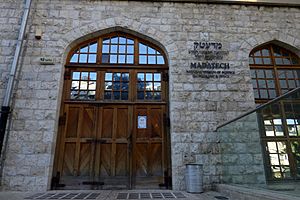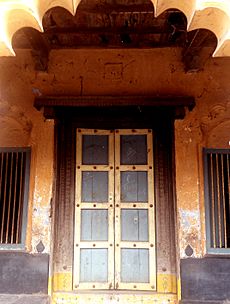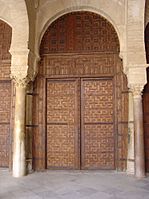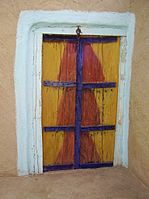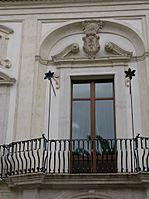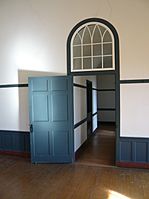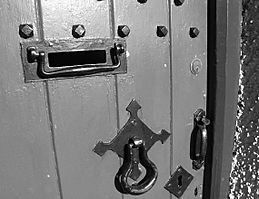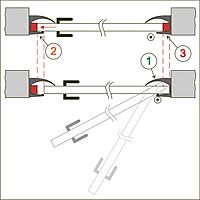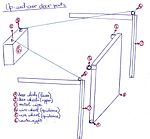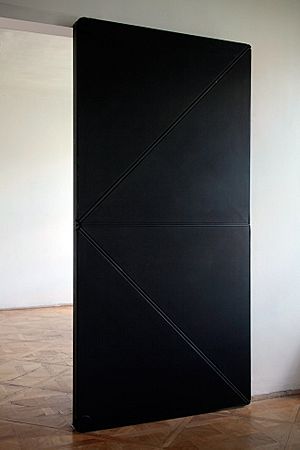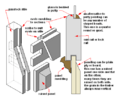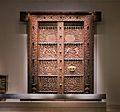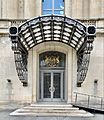Door facts for kids
A door is a hard, flat object a person can open and close so that person can go into a room or other place. It is found in houses and other buildings. Doors are also found in cars and cages.
The reasons for a door are:
- for people, animals, and objects to go through; some doors are for emergencies only (emergency exit)
- to keep cold or hot air outside (or inside, such as the door on a refrigerator)
- so that people cannot see or hear what happens on the other side (privacy and stopping noise)
- so that people do not fall out of the car or other vehicle
- so a person can decide who to let in—many doors have a lock
Contents
Design and styles
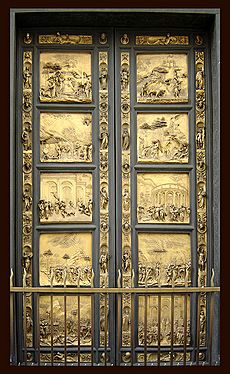
There are many kinds of doors, with different purposes. The most common type is the single-leaf door, which consists of a single rigid panel that fills the doorway. There are many variations on this basic design, such as the double-leaf door or double door and French windows, which have two adjacent independent panels hinged on each side of the doorway.
- A half door or Dutch door or stable door is divided in half horizontally. Traditionally the top half can be opened to allow a horse or other animal to be fed, while the bottom half remains closed to keep the animal inside. This style of door has been adapted for homes.
- Saloon doors are a pair of lightweight swing doors often found in public bars, and especially associated with the American west. Saloon doors, also known as cafe doors, often use bidirectional hinges that close the door regardless of which direction it is opened by incorporating springs. Saloon doors that only extend from knee-level to chest-level are known as batwing doors.
- A blind door, Gibb door, or jib door has no visible trim or operable components. It is designed to blend with the adjacent wall in all finishes, and visually to be a part of the wall, a disguised door.
- A French door consists of a frame around one or more transparent or translucent panels (called lights or lites) that may be installed singly, in matching pairs, or even as series. A matching pair of these doors is called a French window, as it resembles a door-height casement window. When a pair of French doors is used as a French window, the application does not generally include a central mullion (as do some casement window pairs), thus allowing a wider unobstructed opening. The frame typically requires a weather strip at floor level and where the doors meet to prevent water ingress. An espagnolette bolt may allow the head and foot of each door to be secured in one movement. The slender window joinery maximizes light into the room and minimizes the visual impact of the doorway joinery when considered externally. The doors of a French window often open outward onto a balcony, porch, or terrace and they may provide an entrance to a garden.
- A louvred door has fixed or movable wooden fins (often called slats or louvers) which permit open ventilation while preserving privacy and preventing the passage of light to the interior. Being relatively weak structures, they are most commonly used for wardrobes and drying rooms, where security is of less importance than good ventilation, although a very similar structure is commonly used to form window shutters. Double louvred doors were introduced into Seagate, built in Florida in 1929 by Gwendolyn and Powel Crosley, that provided the desired circulation of air with an added degree of privacy in that it is impossible to see through the fins in any direction.
- A composite door is a single leaf door that can be solid or with glass, and is usually filled with high density foam. In the United Kingdom, it is common for composite doors to be certified to BS PAS 23/24 and be compliant with Secured by Design, an official UK police initiative.
- A steel security door is one which is made from strong steel, often for use on vaults and safe rooms to withstand attack. These may also be fitted with wooden outer panels to resemble standard internal and external doors.
- A flush door is a completely smooth door, having plywood or MDF fixed over a light timber frame, the hollow parts of which are often filled with a cardboard core material. Skins can also be made out of hardboards, the first of which was invented by William H Mason in 1924. Called Masonite, its construction involved pressing and steaming wood chips into boards. Flush doors are most commonly employed in the interior of a dwelling, although slightly more substantial versions are occasionally used as exterior doors, especially within hotels and other buildings containing many independent dwellings.
- A moulded door has the same structure as that of flush door. The only difference is that the surface material is a moulded skin made of MDF. Skins can also be made out of hardboards.
- A ledge and brace door often called plank or batten doors are made from multiple vertical planks or narrower battens fixed together by two or more horizontal timbers called ledges and sometimes kept square by additional diagonal timbers called braces.
- A wicket door is a pedestrian door built into a much larger door allowing access without requiring the opening of the larger door. Examples might be found on the ceremonial door of a cathedral or in a large vehicle door in a garage or hangar.
- A bifold door is a unit that has several sections, folding in pairs. Wood is the most common material, and doors may also be metal or glass. Bifolds are most commonly made for closets, but may also be used as units between rooms. Bi-fold doors are essentially now doors that let the outside in. They open in concert; where the panels fold up against one another and are pushed together when opened. The main door panel (often known as the traffic door) is accompanied by a stack of panels that fold very neatly against one another when opened fully, which almost look like room dividers.
- A sliding glass door, sometimes called an Arcadia door or patio door, is a door made of glass that slides open and sometimes has a screen (a removable metal mesh that covers the door).
- Australian doors are a pair of plywood swinging doors often found in Australian public houses. These doors are generally red or brown in color and bear a resemblance to the more formal doors found in other British Colonies' public houses.
- A false door is a wall decoration that looks like a door. In ancient Egyptian architecture, this was a common element in a tomb, the false door representing a gate to the afterlife. They can also be found in the funerary architecture of the desert tribes (e.g., Libyan Ghirza).
- Design and styles
-
Front door of a house with typical door furniture: a letter box, door knocker, a latch and two locks
Types of mechanism
Hinged doors
Most doors are hinged along one side to allow the door to pivot away from the doorway in one direction, but not the other. The axis of rotation is usually vertical. In some cases, such as hinged garage doors, the axis may be horizontal, above the door opening.
Doors can be hinged so that the axis of rotation is not in the plane of the door to reduce the space required on the side to which the door opens. This requires a mechanism so that the axis of rotation is on the side other than that in which the door opens. This is sometimes the case in trains or airplanes, such as for the door to the toilet, which opens inward.
A swing door has special double-action hinges that allow it to open either outwards or inwards, and is usually sprung to keep it closed.
A selfbolting door has special hinges that permit the panel leaf to move laterally, so that the door itself becomes a giant bolt for better security. The selfbolting door principle can be used both for hinged doors as for rotating doors, as well as up-and-over doors (in the latter case, the bolts are then placed at top and bottom rather than at the sides).
French doors are derived from an original French design called the casement door. It is a door with lites where all or some panels would be in a casement door. A French door traditionally has a moulded panel at the bottom of the door. It is called a French window when used in a pair as double-leaved doors with large glass panels in each door leaf, and in which the doors may swing out (typically) as well as in.
A Mead door, developed by S Mead of Leicester, swings both ways. It is susceptible to forced entry due to its design.
A Dutch door or stable door consists of two halves. The top half operates independently from the bottom half. A variant exists in which opening the top part separately is possible, but because the lower part has a lip on the inside, closing the top part, while leaving the lower part open, is not.
A garden door resembles a French window (with lites), but is more secure because only one door is operable. The hinge of the operating door is next to the adjacent fixed door and the latch is located at the wall opening jamb rather than between the two doors or with the use of an espagnolette bolt.
Sliding doors
It is often useful to have doors which slide along tracks, often for space or aesthetic considerations.
A bypass door is a door unit that has two or more sections. The doors can slide in either direction along one axis on parallel overhead tracks, sliding past each other. They are most commonly used in closets, in order to access one side of the closet at a time. The doors in a bypass unit will overlap slightly when viewed from the front, in order not to have a visible gap between them.
Doors which slide between two wall panels are called pocket doors.
Sliding glass doors are common in many houses, particularly as an entrance to the backyard. Such doors are also popular for use for the entrances to commercial structures, although they are not counted as fire exit doors. The door that moves is called the "active leaf", while the door that remains fixed is called the "inactive leaf".
Rotating doors
A revolving door has several wings or leaves, generally four, radiating from a central shaft, forming compartments that rotate about a vertical axis. A revolving door allows people to pass in both directions without colliding, and forms an airlock maintaining a seal between inside and out.
A pivot door, instead of hinges, is supported on a bearing some distance away from the edge, so that there is more or less of a gap on the pivot side as well as the opening side. In some cases the pivot is central, creating two equal openings.
High-speed door
A high-speed door is a very fast door some with opening speeds of up to 4 m/s, mainly used in the industrial sector where the speed of a door has an effect on production logistics, temperature and pressure control. High Speed Clean Room Doors are used in Pharmaceutical industries for the special curtain and stainless steel frames. They guarantee the tightness of all accesses. The powerful high-speed doors have a smooth surface structure and no protruding edges. Therefore, they can be easily cleaned and depositing of particles is largely excluded. High-speed doors are made to handle a high number of openings, generally more than 200000 a year. They need to be built with heavy duty parts and counterbalance systems for speed enhancement and emergency opening function. The door curtain was originally made of PVC, but was later also developed in aluminium and acrylic glass sections. High Speed refrigeration and cold room doors with excellent insulation values was also introduced with the Green and Energy saving requirements.
In North America, the Door and Access Systems Manufacturing Association (DASMA) defines high-performance doors as non-residential, powered doors, characterized by rolling, folding, sliding or swinging action, that are either high-cycle (minimum 100 cycles/day) or high-speed (minimum 20 inches(508 mm)/second), and two out of three of the following: made-to-order for exact size and custom features, designed to be able to withstand equipment impact (break-away if accidentally hit by vehicle) or designed to sustain heavy usage with minimal maintenance.
Automatic
Automatically opening doors are powered open and closed either by electricity, spring, or both. There are several methods by which an automatically opening door is activated:
- A sensor detects traffic is approaching. Sensors for automatic doors are generally:
- A pressure sensor – e.g., a floor mat which reacts to the pressure of someone standing on it.
- An infrared curtain or beam which shines invisible light onto sensors; if someone or something blocks the beam the door is triggered open.
- A motion sensor which uses low-power microwave radar for the same effect.
- A remote sensor (e.g. based on infrared or radio waves) can be triggered by a portable remote control, or is installed inside a vehicle. These are popular for garage doors.
- A switch is operated manually, perhaps after security checks. This can be a push button switch or a swipe card.
- The act of pushing or pulling the door triggers the open and close cycle. These are also known as power-assisted doors.
In addition to activation sensors automatically opening doors are generally fitted with safety sensors. These are usually an infrared curtain or beam, but can be a pressure mat fitted on the swing side of the door. The purpose of the safety sensor is to prevent the door from colliding with an object in its path by stopping or slowing its motion.A mechanism is set in modern automatic doors to ensure that door will be in open state in case of power failure.
Others
Up-and-over or overhead doors are often used in garages. Instead of hinges it has a mechanism, often counterbalanced or sprung, that allows it to be lifted so that it rests horizontally above the opening. A roller shutter or sectional overhead door is one variant of this type.
A tambour door or roller door is an up-and-over door made of narrow horizontal slats and "rolls" up and down by sliding along vertical tracks and is typically found in entertainment centres and cabinets.
Inward opening doors are doors that can only be opened (or forced open) from outside a building. Such doors pose a substantial fire risk to occupants of occupied buildings when they are locked. As such doors can only be forced open from the outside, building occupants would be prevented from escaping. In commercial and retail situations manufacturers have included in the design a mechanism that allows an inward opening door to be pushed open outwards in the event of an emergency (which is often a regulatory requirement). This is known as a 'breakaway' feature. Pushing the door outward at its closed position, through a switch mechanism, disconnects power to the latch and allows the door to swing outward. Upon returning the door to the closed position, power is restored.
Rebated doors, a term chiefly used in Britain, are double doors having a lip or overlap (i.e. a Rabbet) on the vertical edge(s) where they meet. Fire-rating can be achieved with an applied edge-guard or astragal molding on the meeting stile, in accordance with the American Fire door.
Evolution Door is a trackless door that moves in the same closure level as a sliding door. The system is an invention of the Austrian artist Klemens Torggler. From the technical point of view the Evolution Door is a further development (evolution) of the Drehplattentür that normally consists of two rotatable, connected panels which move to each other when opening.
Applications
Architectural doors have numerous general and specialized uses. Doors are generally used to separate interior spaces (closets, rooms, etc.) for convenience, privacy, safety, and security reasons. Doors are also used to secure passages into a building from the exterior, for reasons of climate control and safety.
Doors also are applied in more specialized cases:
- A Blast-proof door is constructed to allow access to a structure as well as to provide protection from the force of explosions.
- A garden door is any door that opens to a backyard or garden. This term is often used specifically for French windows, double French doors (with lites instead of panels), in place of a sliding glass door. The term also may refer to what is known as patio doors.
- A jib door is a concealed door, whose surface reflects the moldings and finishes of the wall. These were used in historic English houses, mainly as servants' doors.
- A pet door (also known as a cat flap or dog door) is an opening in a door to allow pets to enter and exit without the main door's being opened. It may be simply covered by a rubber flap, or it may be an actual door hinged on the top that the pet can push through. Pet doors may be mounted in a sliding glass door as a new (permanent or temporary) panel. Pet doors may be unidirectional, only allowing pets to exit. Additionally, pet doors may be electronic, only allowing animals with a special electronic tag to enter.
- A trapdoor is a door that is oriented horizontally in a ceiling or floor, often accessed via a ladder.
- A water door or water entrance, such as those used in Venice, Italy, is a door leading from a building built on the water, such as a canal, to the water itself where, for example, one may enter or exit a private boat or water taxi.
Images for kids
-
Roman wall painting of an ornate door, in the Villa Boscoreale (Italy), from the first century AD
-
Glass door decorated with Art Nouveau elements, from the Singer House (Saint Petersburg, Russia)
-
Door of the Florence Baptistery called The Gates of Paradise, 1425–1452, gilded bronze, height: 5.2 m
-
Entrance of the Kunsthistorisches Museum (Vienna, Austria)
-
Transparent awning in Luxembourg, above a door
-
Fragment from an Ancient Egyptian tomb door, circa 2150 –1981 BC, in the Metropolitan Museum of Art (New York City)
-
Ancient Greek door carved on the Hercules sarcophagus from the Kayseri Archaeology Museum (Kayseri, Turkey)
-
Traditional Chinese folding doors in The Old Museum of Wisteria (Changzhou, China)
-
Islamic door decorated with geometric patterns in Morocco
-
Romanesque door of the Saint Nicholas' Church in Barfrestone (Kent, England)
-
Gothic door of the St Magnus Cathedral (Kirkwall, Scotland)
-
Russian door in Saint Basil's Cathedral (Moscow)
-
Brâncovenesc door of the Antim Monastery (Bucharest, Romania), with a pisanie above it
-
Renaissance door in Gdańsk (Poland)
-
Baroque door in the Palace of Versailles (Versailles, France)
-
Rococo door on Rue Monsieur-le-Prince (Paris)
-
African door with lock, late 19th or early 20th century, wood with iron, from Burkina Faso, in the Brooklyn Museum (New York City)
-
A decorated door from the Gandantegchinlen Monastery (Mongolia)
-
Gothic Revival door on Rue Malebranche (Paris)
-
Egyptian Revival door of a mausoleum in the Forest Home Cemetery (Wisconsin, US)
-
Rococo Revival door of the Hôtel de Breteuil (Paris)
-
Art Nouveau metal and glass door in Nancy (France), with a big transparent awning above it
-
Hinge of a door of the St Pancras railway station (London)
See also
 In Spanish: Puerta para niños
In Spanish: Puerta para niños


